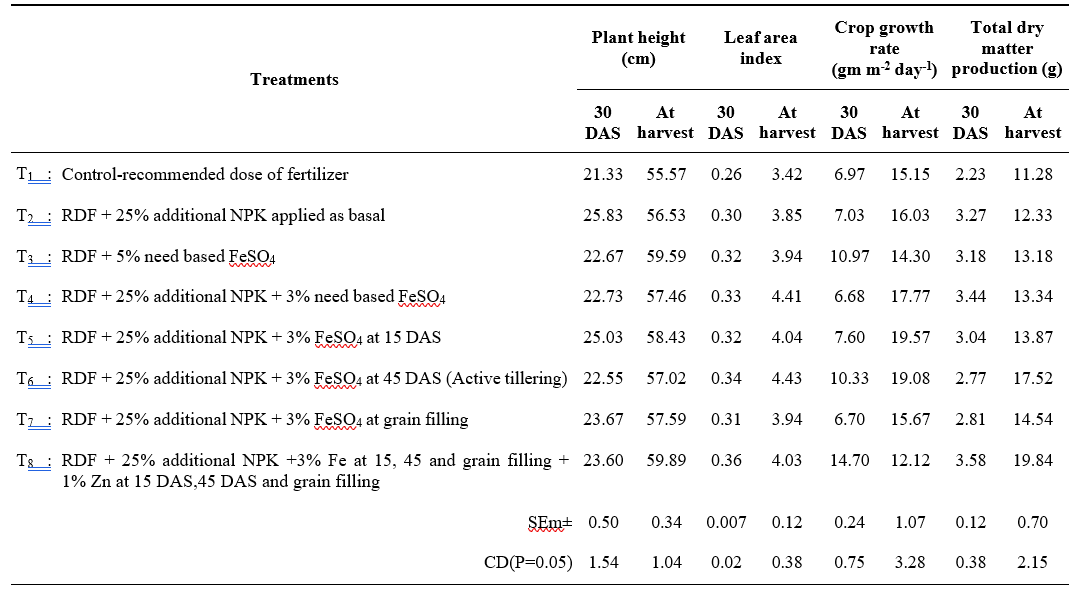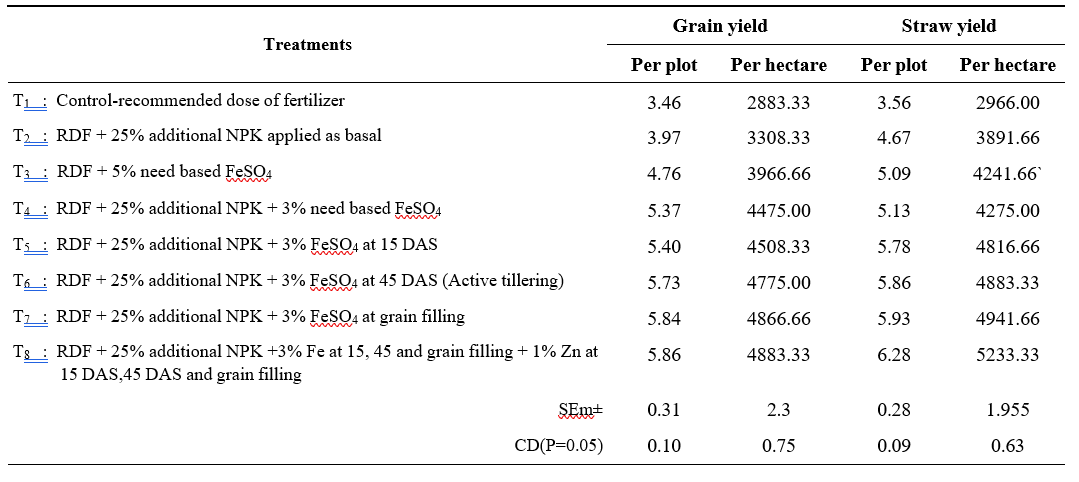Influence of Iron, Zinc and Supplemental N P K on Yield and Yield Attributes of Dry Direct Sown Rice
0 Views
Y. GANESH*, A.R. NIRMAL KUMAR, S. TIRUMALA REDDY, P. SANDYARANI AND V. UMAMAHESH
Department of Crop Physiology, S.V. Agricultural College, ANGRAU, Tirupati-517 502.
ABSTRACT
The present experiment entitled “Influence of iron, zinc and supplemental NPK on yield and yield attributes of dry direct sown rice” was done at wetland farm of S.V. Agricultural College, ANGRAU, Tirupati during Summer, 2023. Three replications were used in the randomised block design of the experiment. The results revealed that the treatment involving RDF + 25 % additional NPK + 3% FeSO4 at 15, 45, and grain filling + 1% ZnSO4 at 15 DAS, 45 DAS and grain filling exhibited superior performance across all growth parameters such as plant height, leaf area index and dry matter production at 30 DAS and at harvest. Furthermore, compared to all other treatments, this one produced a significantly higher grain yield and straw yield.
KEYWORDS: Dry direct rice, Ferrous sulphate, Grain yield, Growth parameters and Zinc sulphate.
INTRODUCTION
Rice (Oryza sativa L.) is considered as a staple food for more than half of the global population and sustaining productivity under scarcity of resources is challenging to meet the future food demands of the inflating global population. About 90% of the global rice is cultivated in Asia, the topmost continent for rice cultivation (Wassmann et al., 2009; Rose et al., 2014), where China is the largest grower and producer (Tang et al., 2014) constituting 30% of global rice production (Zhang et al., 2015). Rice is one of the most important field crops after wheat in the world producing 509.87 MT from an area of 164.19 M ha with 3105.36 kg ha-1 productivity during 2020-2021.
Rice is an important crop of our national food security and provides a source of income for millions of rural families. It is an indispensable source of calories for almost half of the population with in Asia. Rice is a energy rich crop, it contains 3470 kcal kg-1 of grains, 76- 79 per cent carbohydrates, 6.4-8.5 per cent protein and 0.4-1.4 per cent fat.
In direct seeding, availability of several nutrients including N, P, K and micronutrients such as Zn and Fe are reported to be a constraint in realization of production potential of rice. Micronutrients, particularly zinc and iron have attained a great significance in today’s intensive and exploitive agriculture with higher crop productivity. Nitrogen is one of the major mineral nutrients that share greater roles in photosynthetic pathways, hormonal and enzymatic processes and other proteomic changes, which are necessary for the growth and developmental stages of plants (Balestrini et al., 2020; Sandhu et al., 2021).
A crucial micronutrient that is important for plants is iron (Fe), which is important for a number of physiological and biological processes. It is necessary for a wide range of biological processes and is a component of numerous essential enzymes. Because soil’s accessible ferrous form oxidizes to an unusable ferric form under aerobic conditions, iron shortage is more pronounced.
One of the micronutrients that is crucial for plants, animals and people alike is zinc. Zinc is involved in a variety of fundamental biochemical activities, including protein synthesis, glucose and auxin metabolism, chlorophyll production, pollen development, cytochrome, nucleotide synthesis, membrane integrity maintenance and energy dissipation.
Micronutrients like Zn and Fe are the major concern of dry direct seeded rice. Zinc deficiency occurs due to high pH and high carbonate content and more bicarbonates in calcareous soils which immobilize Zn because of inhibition effect. Iron availability becomes limited due high pH in the soil and it becomes another major constraint in dry direct seeded rice.
In this study, the impact of applying ferrous sulphate and zinc sulphate on dry direct seed sown rice growth and yield was investigated.
Table 1. Application of Iron sulphate, Zinc sulphate and supplemental N, P and K Influence on growth parameters of dry direct sown rice

Table 2. Influence of iron, zinc and supplemental N, P, K on grain yield (kg plot-1, kg ha-1) and straw yield (kg plot-1, kg ha-1) of dry direct sown rice

MATERIAL AND METHODS
The present investigation entitled “Influence of iron, zinc and supplemental NPK on yield and yield attributes of dry direct sown rice” was done at wetland farm of S.V. Agricultural College, ANGRAU, Tirupati during Summer, 2023. The soil was sandy clay loam in texture, alkaline in soil reaction (8.64 pH), low in organic carbon(0.27 %), medium in available phosphorous (41.04 kg ha-1) and potassium, low in available nitrogen (201 kg ha-1),low in available iron (2.01 kg ha-1), zinc (0.83 kg ha-1). Three replications of the experiment were done using a randomised block design. Treatments includes T1-control– recommended dose of fertilizer; T2– RDF + 25% additional NPK applied as basal; T3-RDF + 5% need based FeSO4; T4– RDF + 25% additional NPK + 3% need based FeSO4; T5– RDF+ 25% additional NPK+ 3% FeSO4 @ 15 DAS; T6– RDF + 25% additional NPK + 3% FeSO4 @ 45 DAS (Active tillering); T7– RDF + 25% additional NPK + 3% FeSO4 @ grain filling; T8– RDF + 25% additional NPK + 3% FeSO4 @ 15, 45, and grain filling + 1% ZnSO4 @ 15 DAS, 45 DAS, and grain filling. The crop was shown at 22.5 × 10 cm spacing with a seed rate of 25 kg ha-1. Recommended dose of fertilizer was 120 – 60 – 40 N, P2O5, K2O kg ha-1. The data collected on various crop parameters were statistically evaluated using the randomised block design method recommended by Panse and Sukhatme (1985).
RESULTS AND DISCUSSION
Growth Parameters
All the growth parameters of dry direct rice viz., plant height, leaf area index, crop growth rate and dry matter production significantly recorded higher values with the application of RDF + 25% additional NPK + 3% FeSO4 @ 15, 45 and grain filling + 1% ZnSO4 @ 15 DAS, 45 DAS and grain filling (T8) But it was found to be on par with T6 (RDF + 25% additional NPK + 3% Fe @ 45 DAS (Active tillering) The lowest values were recorded with control (T1) (Table 1). Higher plant height attained may be due to better inter-node elongation and good vegetative growth through-out the crop cycle. Iron has a structural role in chlorophyll, energy transfer within the plant, and enters in root cells also zinc increased the plant height via increasing the intermodal distance. Similar results were also obtained by Ananda and Patil (2010). Foliar application of micronutrients significantly increased the plant height which might be attributed to the adequate supply of micronutrients contributed to accelerate the enzymatic activity and auxin metabolism in plants (Sudha and Stalin, 2015). Kandoliya et al. (2018) and Balachandrakumar and Rao (2018) also reported that an increase in plant height was observed with combined application of Zinc and Iron.
Grain and straw yield
Higher grain and straw yield of dry direct rice was recorded with RDF + 25% additional NPK + 3% FeSO4 @ 15, 45, and grain filling + 1% ZnSO4 @ 15 DAS, 45 DAS, and grain filling (T8) which was on par with RDF + 25% additional NPK + 3% Fe @ 45 DAS (Active tillering) (T6). Statistically lower grain and straw yields were noticed with control (T1) (Table 2). Zinc and iron plays a major role in biosynthesis of IAA and especially due to its role in initiation of primordial reproductive part and portioning of photosynthetic towards them which promotes the yield (Barua and Saika, 2018). Applying iron in aerobic rice improved the dry matter production, eventually leading to increased straw yield (Vikashkumar et al., 2015). The increase in straw yield is attributed to improved crop growth rate and higher dry matter production in those treatments receiving foliar iron and zinc nutrition, along with additional NPK supplementation, when compared to the control. Similar results were reported by the researchers Esfahani et al. (2014) and Meena et al. (2016).
In conclusion, the present research indicated that T8 (RDF + 25% additional NPK + 3% FeSO4 at 15, 45 and grain filling + 1% ZnSO4 at 15 DAS, 45 DAS and grain filling showed better performance on physiological and yield parameters of dry direct seed sown rice which was reflected in increase of grain yield.
LITERATURE CITED
Ananda, N and Patil, B.N. 2010. Effect of micronutrients (Zn and Fe) and time of nitrogen application on growth and yield of Durum Wheat. Karnataka Journal of Agricultural Sciences. 18(3): 12.
Balachandrakaumar, V and Rao, G.B.S. 2018. Yield and economics of rice as fortification with zinc and iron fertilizer. Plant Archive. 18 (Special issue ICAAAS) 14: 400- 03.
Balestrini, R., Brunetti, C., Chitarra, W and Nerva, L. 2020. Photosynthetic traits and nitrogen uptake in crops: which is the role of arbuscular mycorrhizal fungi. Plants. 9(9): 1105.
Barua, D and Saikia, M. 2018. Agronomic biofortification in rice verities through Zn fertilization under aerobic condition. Indian Journal of Agricultural Research. 52(1): 89-92.
Esfahani, A.A., Pirdashti, H and Niknejhad, Y. 2014. Effect of iron, zinc and silicon application on quantitative parameters of rice (Oryza Sativa L. CV. Tarom Mahalli). International Journal of Farming and Allied Sciences. 3(5): 529-533.
Rushang, U.K., Babulal, B.K and Ba, G. 2018. Efficacy of different combination of chemical fertilizer doses on yield of groundnut in Saurastra region. IJCS. 6(4): 3047-3050.
Meena, B.L., Rattan, R.K., Datta, S.P and Meena, M.C. 2016. Effect of iron application on iron nutrition of aerobic rice grown in different soils. Journal of Environmental Biology. 37: 1377-1383.
Panse, V.G and Sukhatme, P.V. 1985. Statistical Methods for Agricultural Workers. ICAR, New Delhi. 100-174.
Rose, M.T., Patti, A.F., Little, K.R., Brown, A.L., Jackson, W.R and Cavagnaro, T.R. 2014. A meta- analysis and review of plant-growth response to humic substances: practical implications for agriculture. Advances in Agronomy. 124: 37-89.
Sandhu, N., Sethi, M., Kumar, A., Dang, D., Singh, J and Chhuneja, P. 2021. Biochemical and genetic approaches improving nitrogen use efficiency in cereal crops: A review. Frontiers in Plant Science. 12: 657629.
Sudha., S and Stalin., P. 2015. Effect of zinc on yield, quality and grain zinc content of rice genotypes. International Journal of Farm Science. 5(3):17-27.
Tang, H., Pang, J., Zhang, G., Takigawa, M., Liu, G., Zhu, J and Kobayashi, K. 2014. Mapping ozone risks for rice in China for years 2000 and 2020 with flux-based and exposure-based doses. Atmospheric Environment. 86: 74-83.
Vikashkumar, V., Kumar, D., Singh Y.V and Raj. R. 2015. Effect of iron fertilization on dry-matter production, yield and economics of aerobic rice (Oryza sativa). Indian Journal of Agronomy. 60(4): 547-553.
Wassmann, R., Jagadish, S.V.K., Sumfleth, K., Pathak, H., Howell, G., Ismail, A., Serraj, R., Redona, E., Singh, R.K and Heuer, S. 2009. Regional vulnerability of climate change impacts on Asian rice production and scope for adaptation. Advances in Agronomy. 102: 91-133.
Zhang, J., Feng, L., Zou, H and Li Liu, D. 2015. Using ORYZA 2000 to model cold rice yield response to climate change in the Heilongjiang province, China. The Crop Journal. 3(4): 317-327.
- Genetic Divergence Studies for Yield and Its Component Traits in Groundnut (Arachis Hypogaea L.)
- Correlation and Path Coefficient Analysis Among Early Clones Of Sugarcane (Saccharum Spp.)
- Character Association and Path Coefficient Analysis in Tomato (Solanum Lycopersicum L.)
- Survey on the Incidence of Sesame Leafhopper and Phyllody in Major Growing Districts of Southern Zone of Andhra Pradesh, India
- Effect of Organic Manures, Chemical and Biofertilizers on Potassium Use Efficiency in Groundnut
- A Study on Growth Pattern of Red Chilli in India and Andhra Pradesh

